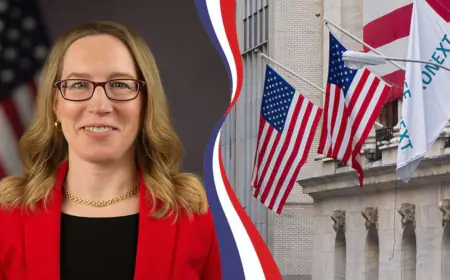Brendan Blumer: From Gaming Teen to Blockchain Pioneer
Brendan Blumer started his entrepreneurial journey at 15, selling virtual assets for online games like World of Warcraft. Blumer co-founded Block.one and launched EOS.IO, aiming to solve blockchain scalability and support decentralized applications. Brendan Blumer is one of the most well-known figures in the rapidly changing world of blockchain and cryptocurrency. Blumer’s journey from a [...]


- Brendan Blumer started his entrepreneurial journey at 15, selling virtual assets for online games like World of Warcraft.
- Blumer co-founded Block.one and launched EOS.IO, aiming to solve blockchain scalability and support decentralized applications.
Brendan Blumer is one of the most well-known figures in the rapidly changing world of blockchain and cryptocurrency. Blumer’s journey from a teenage entrepreneur to a big participant in the cryptocurrency industry is nothing short of remarkable.
This article dives into his background, detailing his early enterprises, watershed moments, and subsequent developments that have cemented his name in the industry.
Brendan Blumer: Early Ventures and Initial Successes
Brendan Blumer’s entrepreneurial zeal was sparked at the age of 15 when he founded his first business, selling virtual items for online games like World of Warcraft.
His website, GaMeCliff, catered to MMORPG fans by listing various in-game things and characters, capitalizing on the growing market for digital goods. This early accomplishment paved the way for his business skills and inventive approach.
Blumer founded Accounts.net, a virtual game character and asset trade platform, in 2007. The venture immediately proved profitable, collecting more than $1 million in monthly sales within a few months.
With the help of Okay.com, a property rental company that showcased Blumer’s entrepreneurial adaptability, he entered the Asia-Pacific real estate market.
Blumer started exploring blockchain and cryptocurrency in 2016. He saw a chance to make a huge contribution after being drawn to blockchain technology’s disruptive power.
After making initial investments in digital assets, Blumer’s interest in blockchain grew. He saw it as “the next, more secure iteration of the internet,” which would fuel his future activities.
During this time, Blumer collaborated with Daniel Larimer, a well-known member in the blockchain world who has worked on BitShares and Steemit. They co-founded Block.one with the goal of building a scalable and efficient blockchain platform.
This partnership resulted in the development of EOS.IO, which attempted to solve the shortcomings of existing platforms such as Ethereum.
The Impactful Launch of EOS.IO
The launch of EOS.IO was a watershed moment in Blumer’s career. The platform was created to support decentralized apps (DApps) with high performance and scalability, promoting itself as a possible “Ethereum killer.”
EOS.IO’s ability to process a huge number of transactions per second made it an appealing alternative for widespread adoption, addressing the scalability difficulties that hampered earlier blockchain networks.
Block.one’s initial coin offering (ICO) for EOS was one of the largest in history, raising almost $4 billion. This large inflow of finance not only confirmed investor trust in the project, but also put enormous pressure on Blumer and his team to keep their promises.
Despite regulatory hurdles, including a settlement with the SEC for failing to register the ICO, Block.one persevered and innovated.
Strategic Acquisition of Silvergate Capital
In 2022, Blumer made waves with a large acquisition. He and Block.one acquired a 9.27% interest in Silvergate Capital, a cryptocurrency-friendly bank recognized for its crypto-to-fiat gateway network.
This move made Blumer and Block.one Silvergate’s largest shareholders, demonstrating their strategy of integrating existing banking institutions with blockchain technology.
The acquisition was part of Blumer’s larger aim to improve the infrastructure that supports digital assets and blockchain applications.
Blumer hoped to bridge the gap between traditional banking and the developing crypto economy by collaborating with major financial institutions, allowing for more widespread adoption and integration of blockchain technologies.
Despite his accomplishments, Blumer’s path has not been without obstacles. EOS investors filed various class-action lawsuits against Block.one over money-raising difficulties and the resulting market performance of the EOS token.
Furthermore, the platform has been criticized for its alleged centralization, with only 21 block makers monitoring the network, as opposed to thousands of nodes in other blockchain networks like Ethereum.
These controversies have spurred discussions in the crypto community concerning the trade-offs between scalability and decentralization.
While EOS.IO’s design allows for increased transaction throughput, its governance mechanism has prompted worries about potential centralization and power concentration among a small number of block producers.
Vision for the Future and Strategic Investments
Looking ahead, Blumer remains committed to accelerating the adoption of blockchain technology across multiple industries. He sees EOS.IO as a premier platform for decentralized apps, capable of supporting corporate solutions with great performance and dependability.
Blumer hopes to establish EOS.IO as a key component of the blockchain ecosystem by tackling scalability challenges and improving interoperability.
Blumer’s latest investments, such as the acquisition of Silvergate Capital, demonstrate his strategic approach to developing a strong foundation for digital assets. His efforts to combine established banking institutions with blockchain technology demonstrate his belief in the technology’s transformational potential.
What's Your Reaction?








































































































